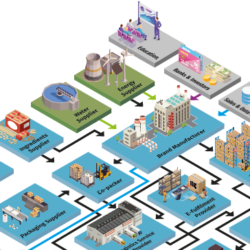Ecosystem for household products

Due to numerous disruptions and rapidly changing needs, the market has evolved from traditional, largely stable linear supply chains into dynamic global supply chain ecosystems. During the pandemic, the market for household products experienced new challenges and unexpected surges in demand. To support the necessary collaboration and digitalization, software vendor Oracle and Supply Chain Media have visualized the ecosystem for household products, showing the interrelationships between suppliers, buyers, service providers, governments and groups of customers.
The COVID-19 pandemic has dramatically altered the worldwide retail and consumer packaged goods (CPG) market. For both sides, the primary goal has changed from manufacturing and selling products efficiently, to a broader promise based on purpose-driven products, global sustainability and corporate social responsibility.
The current wave of innovation – driven by the rise of the internet, advanced new technologies and improved information systems – is transforming business processes in a matter of months rather than years or even decades. At the same time, the pandemic exposed the vulnerabilities of global supply chains that were built for trade partners but are now inextricably linked to the emotions and mindsets of often indistinct groups of consumers.
With the world now emerging from lockdown, the household products market has not only reached a tipping point but also the point of no return. Consumers who experimented with buying such goods online have become accustomed to the new-found convenience.
From linear to circular
The traditional supply chain was linear: products went from factories to distribution centres to retail storerooms and then onto shelves… and now, that supply chain increasingly ends directly at the consumer’s front door. The traditional model was more predictable and manageable than the new omnichannel ecosystem which is made up of multiple supply chains – including ones involving dark stores and on-demand delivery services – serving many different types of consumers.
Today’s consumers expect a higher level of transparency and traceability: What are the origins of the raw materials used in the product? Which labour practices were involved, and are they visibly certified? And how have the products reached the market?
A growing number of brand manufacturers and retailers are noticing that shoppers’ buying preferences are changing based on these and similar issues, including health and product safety, corporate social responsibility, inclusiveness and environmental impact. In view of the need to use more organic raw materials and recycle more packaging, the supply chain ecosystem for household products – and other consumer goods – is changing rapidly, and all the participants in that ecosystem will need to adapt, digitalize and collaborate.
Download the Ecosystem for household products
Fill in the form below and get the Ecosystem for household products in your inbox.










